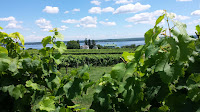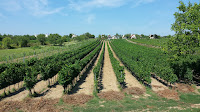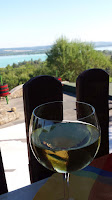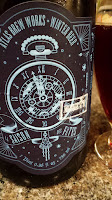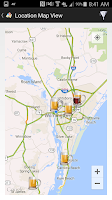
A family wedding lead me to Wilmington North Carolina where I found a thriving beer culture. Not only were their several excellent beer bars, a local bookstore (
Old Books on Front St.) served beer, wine, and mead. And this port city is home to several breweries, most of which I was able to visit or at a minimum sample a beer. Regrets to
BroomTail Craft Brews as the one brewery I completely missed.

We started the weekend with lunch at
Front Street Brewery, a brewpub located in a 1865 era building and serving microbrews and southern styled pub food . And don't leave without trying the 'Beers'wick Stew or Low Country Grit Cakes. Front Street is also the Granddaddy of the local beer movement having opened a decade ago. Year round they provide eight beers on tap, augmented by a couple seasonals. I thought the
Coastal Kolsch was spot on with the
Dram Tree Scottish Ale a decent wee heavy, although a bit on the sweeter side. The brewery also houses the largest whiskey selection I've ever seen, 300+, that made my eyes water in temptation. Wow.

The bride and groom judiciously provided guests with a goody bag when checking into their hotel room and each bag contained a crowler of
Wilmington Brewing Company Sneaky Goose Double IPA. Yes a crowler -- a 32 ounce canned container. Once the city's premier brewing supply store, the operation now includes a 3bbl brewery and tasting room. And good beer if the Sneaky Goose is any indication as it was heavy, but with a smooth backbone and plenty of aromatics. The brewery also offers a Kolsch, Stout, Saison, and Porter -- next trip.

Before the ceremony a few of us ventured a couple blocks to
Ironclad Brewery, a newcomer that specializes in home grown beer and live music. I tasted over half their menu and all were solid representatives of their respective styles starting with the
Teach's Chocolate Stout. Plenty of smooth chocolate in this one. Two other smooth beers were their two lighter options
Lydia's Lager (Munich Helles Lager) and the
Old Baldy Golden Ale. And the
Fish Tale Pale Ale was rather tasty as it had plenty of citrus in the tail. Wish we had more time to hangout.

It's not a beer trip unless we visit an aquarium or zoo and fortunately for the little one, there's one of each in the beaches south of Wilmington. And along the route
theCompass alerted us to
Good Hops Brewing in Carolina Beach. The brewery is the companion to
Lookout Brewing Company in Black Mountain and brews daily on a 3 barrel system and provide a wide range of ales. A seasonal Saison and the
Donna Golden Ale were nice starts to the session, but the clear favorites were the
Flip Hop IPA and
Bravehop Scotch Ale. The former is a clean IPA, big but refreshing on the palate. The later is currently a sour that requires a few sips to penetrate into the wee heavy flavors. A fantastic beer.

The final stop during the weekend was to the First Anniversary Party at
Flytrap Brewing. And not just any party, a sour beer party. The lineup was stellar, unfortunately no samples so I stuck with the
Gose and
Belgium Blonde aged in Hungarian Oak. The Gose was very unique, stone fruits up front and slightly tart and salty on the back end. The oak aged Belgium was phenomenal; some funk and brett finishing slightly sour. Well worth the high price tag. The brewery was rocking that night with a large crowd and live music. Seems like an appropriate metaphor to the overall Wilmington craft beer scene. Cheers.
